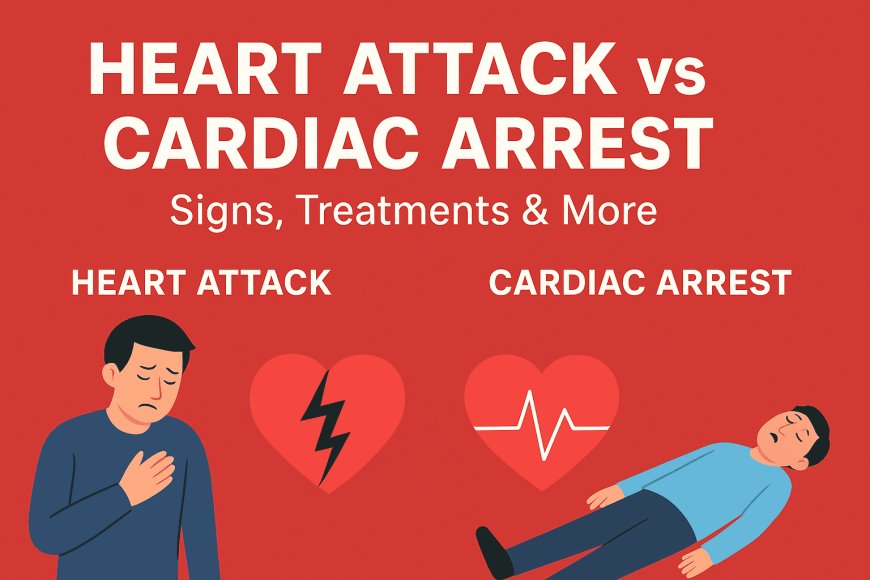Heart Attack vs Cardiac Arrest: Signs Treatments & More
Understand the differences between heart attacks and cardiac arrests, their signs, treatments, and how to respond effectively.

When it comes to heart health, two terms often get tossed around interchangeably: heart attack and cardiac arrest. But did you know that they are not the same thing? Understanding the differences between them can be a matter of life and death. Each condition has its own set of signs and symptoms, and knowing them can help you act quickly in an emergency. In this article, we’ll delve into the specifics of heart attacks and cardiac arrests, including how to recognize them, what treatments are available, and what steps you should take in case of an emergency. So, let’s get started!
Understanding Heart Attacks and Cardiac Arrest
A heart attack, or myocardial infarction, occurs when blood flow to a part of the heart is blocked, usually by a blood clot. This blockage prevents oxygen-rich blood from reaching that part of the heart muscle, leading to damage or death of the heart tissue. Signs and symptoms of a heart attack include chest pain or discomfort, often described as pressure, squeezing, fullness, or pain; radiating pain that may spread to the shoulders, neck, arms, back, teeth, or jaw; shortness of breath, which can occur with or without chest discomfort; and other signs such as cold sweat, nausea, or lightheadedness.
Cardiac arrest, on the other hand, is a sudden loss of heart function, breathing, and consciousness. It happens when the heart's electrical system malfunctions, causing an irregular heartbeat, or arrhythmia. Unlike a heart attack, cardiac arrest is often immediate and can occur without any prior warning. Signs and symptoms of cardiac arrest include sudden collapse, no pulse or breathing, and unresponsiveness to any stimuli, including shouting or shaking.
Key Differences Between Heart Attack and Cardiac Arrest
The causes differ: a heart attack is primarily caused by a blockage in the coronary arteries, often due to plaque buildup, while cardiac arrest can result from a heart attack but may also occur due to arrhythmias, drowning, or severe trauma. Onset also varies: heart attack symptoms usually develop gradually over minutes to hours, whereas cardiac arrest occurs suddenly and without warning. Treatment differs as well; a heart attack requires immediate medical attention, often involving medications to dissolve clots, angioplasty, or surgery, while cardiac arrest requires immediate cardiopulmonary resuscitation (CPR) and defibrillation.
How to Recognize the Signs Early
For heart attacks, signs to watch for include chest discomfort, unexplained sweating, nausea or indigestion (more common in women), and unusual fatigue. For cardiac arrest, sudden collapse, absence of breathing, and weak or no pulse are critical signs that require immediate action.
Treatments for Heart Attack and Cardiac Arrest
Heart attack treatments include medications such as aspirin to thin the blood, thrombolytics to dissolve clots, and antiplatelet agents like clopidogrel to prevent further clots. Surgical procedures include angioplasty and stenting to open blocked arteries and coronary artery bypass grafting (CABG) to create a new pathway for blood flow. Lifestyle changes like eating a heart-healthy diet, engaging in regular exercise, and quitting smoking are also crucial.
For cardiac arrest, immediate CPR is essential. Call for help and start compressions in the center of the chest. Defibrillation with an Automated External Defibrillator (AED) should be used as soon as possible to restore a normal heartbeat. Advanced medical care from emergency responders may include medications and life support interventions.
Preventing Heart Attacks and Cardiac Arrests
Lifestyle modifications are key to prevention. Maintain a healthy diet low in saturated fats, sugars, and sodium while rich in omega-3s, fruits, and vegetables. Engage in at least 150 minutes of moderate exercise each week, manage your weight, attend regular check-ups, and practice stress-reducing techniques such as yoga, meditation, or deep breathing.
FAQs
1. Can a heart attack lead to cardiac arrest?
Yes, a heart attack can cause cardiac arrest, particularly if it leads to severe arrhythmias.
2. Are there different treatments for men and women?
Treatments are generally the same, but women may experience different symptoms and responses.
3. How can I recognize a heart attack if I’m not sure?
If you experience chest pain, discomfort, or shortness of breath, seek medical attention immediately.
4. What should I do if someone collapses?
Call emergency services right away and start CPR if the person is unresponsive and not breathing.
5. Can heart attacks be prevented?
Yes, through lifestyle changes, regular check-ups, and managing risk factors such as high blood pressure and cholesterol.
Conclusion
Understanding the differences between heart attacks and cardiac arrests is crucial for your health and well-being. Recognizing the signs early can save lives, whether it’s your own or someone else's. If you experience any symptoms that could indicate a heart attack, don’t hesitate to seek help. Similarly, knowing how to respond to cardiac arrest can empower you to act decisively in an emergency. Prevention is always better than cure, so adopt a heart-healthy lifestyle today for a healthier tomorrow!





















































